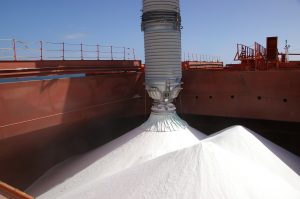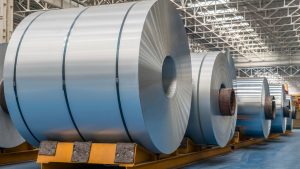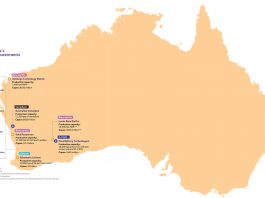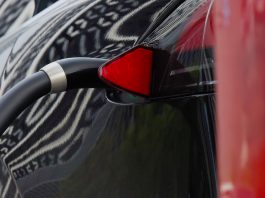Professor Gus Nathan and Dr Woei Saw of the University of Adelaide highlight Australia’s position as a global leader in the production of alumina and aluminium.
The global transition to net zero CO2 emissions offers Australia the opportunity to further enhance its position as a global leader in the production and export of both alumina and aluminium, together being a responsible trading partner. However, we need to continue to invest in the opportunity if we are to capitalise on it.
All of these issues, and more, will be under the spotlight at the upcoming High Temperature Minerals Processing (HiTeMP) Forum. This will bring world leaders to Adelaide in the last week of this September, not only to identify exciting new opportunities to accelerate the low carbon transition for products such as alumina and aluminium but also to foster the partnerships needed to drive it forward.
Australia’s aluminium and alumina production
The Australian Energy Resources Quarterly (March 2022) reports Australia as being the world’s largest producer of bauxite, at 100 Mtpa, of which approximately 60% is converted to 21 tpa of alumina, which also increases its value (per tonne of product) by about ten times.1 This makes Australia the second largest producer of alumina, and its biggest exporter. Some 11% of this alumina product is further upgraded in Australia to produce aluminium, to increase its value (per tonne of product) by another seven times.1 This onshore processing makes the industry Australia’s most successful at value-adding to our mineral resource exports, generating an estimated A$13bn in export revenue alone, while the Australian Aluminium Council estimates that it also directly employs more than 15,000 people and provides employment for another 60,000 families. This already significant benefit could grow even further in the new, low carbon economy – if we overcome the strong competition for this market opportunity.
The current alumina industry was established on the back of low cost natural gas resources. Its future opportunity is based on the promised access to low cost renewable electricity and/or net zero hydrogen. It is being driven by the emergence of new global markets for certified, low carbon aluminium and other materials, which Australia is well positioned to compete for. However, other nations are also investing to position themselves to capture these new markets, so we need to ensure that Australia stays at the forefront of those sectors where we have the most potential to benefit, such as alumina/aluminium.

Australian industry is at the forefront
Demand for low carbon products is growing, with companies like Microsoft and Apple having already announced a plan to transition all of their products to net zero CO2 emissions by 2030. Although it is not yet possible to procure aluminium products that are fully net zero, it is already possible to buy low carbon aluminium. With a carbon intensity of less than one-third of the global average at four tonnes of CO2 per tonne of aluminium, this product is already beginning to attract a premium price.
However, low carbon alumina is presently only available in small quantities from selected locations, such as those where the aluminium smelting step is driven with renewable electricity from hydroelectric plants, so it can only meet one-third of the current demand (Aluminium Stewardship Initiative). This demand is expected to grow even more when net zero products are available. However, achieving a net zero product will require more technological development in the upstream alumina production plant. Both industry and researchers are positioning themselves to be at the forefront of this supply chain, with Australians punching above their weight.
Australian industry is already beginning to demonstrate some of the emerging pathways for low carbon alumina production, with Rio Tinto and Alcoa both announcing projects in this field in partnership with the Australian government through the Australian Renewable Energy Agency (ARENA). Similarly, Australian researchers are collaborating with industry, government, and international research partners through our own Heavy Industry Low-carbon Transition Cooperative Research Centre (HILT CRC), which has begun a series of projects to support the decarbonisation of alumina production.
The HILT CRC has established projects in novel technology to decarbonise both the low-temperature bauxite digestion phase and the high-temperature alumina calcination phase. It has also established work to support the broader decarbonisation of the heavy industrial sector in hydrogen, electrification, and CO2 capture/reuse, including for lime production, which is an industrial chemical used in bauxite digestion, among other industrial processes. Hence, while it will take some years of ongoing investment in technology development and demonstration before this work can be translated to new low carbon products in the market, such investments are already beginning.
Investment and employment opportunities
Even based on current alumina production alone, the low carbon transition will generate huge investment and employment opportunities in Australia through the energy and engineering sectors, to its manufacturing, engineering, construction, and consulting companies. This is because alumina production is presently Australia’s biggest single industrial energy consumer, consuming some 170 PJ per annum (Australian Bureau of Statistics). Were this to be replaced with renewable electrical energy, this would require more than 6 GW of additional electrical capacity on average, which equates to building additional new capacity equal to the average electrical supply of the entire state of Victoria.
The investment needed to build this new generation and transmission and storage infrastructure will be large. Indeed, based on one estimate by the Australian Energy Market Operator (AEMO), it would be approximately A$15bn. To give another reference, this equates roughly to doubling the total renewable infrastructure established in Australia to date, although it would be done with a different mix of generation, storage, and transmission. Thus, it promises to be a significant employer for decades to come.
Although Australia’s supply of aluminium is smaller than that of alumina, at some 1.6 Mtpa, its energy intensity is approximately 16 times greater. Presently, about 90% of national production is supplied from grid electricity, which is predominantly based on fossil fuels, since only the Bell Bay plant in Tasmania runs from hydroelectricity via the Tasmanian grid. Therefore, converting the national aluminium production to run from renewable electricity would increase the scale of investment in green electricity by a further 50% over that needed to electrify the existing alumina production.
An even bigger opportunity would come if the cost of renewable electricity in Australia were to realise its potential of achieving sufficiently low costs relative to international competitors to justify the conversion of a much greater fraction of our existing alumina production to aluminium. This has the potential to easily double the investment needed in electrical infrastructure necessary for alumina, in addition to the seven-fold increase in value described above. This opportunity is based solely on Australia’s present production of alumina. Global demand for electric vehicles (EVs) is expected to significantly increase the demand for new aluminium production since the housing for automotive batteries is made from aluminium.

Hydrogen’s potential role in the production process
Were the net zero energy for the high temperature calcination step in alumina production to be supplied, alternatively, from net zero hydrogen, this would also generate numerous jobs and opportunities, albeit in different ways. For hydrogen to become a more attractive alternative than renewable electricity, a breakthrough in some of the alternative production pathways to bypass the use of electricity is required, since making hydrogen from electricity, except at a relatively small scale, will typically make it more expensive than electricity. However, a number of these alternative routes are under development – and attracting large investment internationally. Should one of them realise its potential, it will be important for Australia to be an early adopter so that it may be best placed to capture the new market opportunities.
As well as the commercially available ‘green’ hydrogen production route, which uses renewable electricity and electrolysis of water, new ‘green’ technology is emerging that bypasses electricity altogether called ‘photocatalysis’, or artificial photosynthesis. This technology, which converts sunlight directly to hydrogen, has recently made some important advances to increase the efficiency of this process so that it is attracting significant investment through companies such as local Australian company, Sparc Technologies.
Similarly, in addition to the commercially established ‘blue’ route to hydrogen production from natural gas, is the approach of methane ‘cracking’ or pyrolysis, sometimes called ‘turquoise’. In contrast to Steam Methane Reforming (SMR), which generates CO2 as a by-product that therefore needs to be sequestered, the pyrolysis route generates two valuable products, both hydrogen and carbon products such as carbon-black. This route requires about half the energy of the conventional ‘blue’ route and a quarter of the conventional ‘green’ route, which is why it is attracting huge investment internationally.
For example, US company Monolith has been awarded a US$1bn loan from the US government. This is but one of a family of new technologies emerging in the field. Together they offer real potential to achieve a significantly lower cost of hydrogen production than conventional blue or green hydrogen, together with low (and potentially net zero) CO2 emissions, although their life cycle emissions will depend both on the source of the methane and the type and use of the carbon product.

Actions for the future
The complexity of the emerging net zero energy supply industry, including that of determining the life cycle CO2 emissions from various methane processes, highlights the need for Australia to ensure we have the capability to be ahead of the game. We need to have the best specialists in all aspects, spanning technology (development, supply, and maintenance) through to regulation, certification, and markets if we are to be a globally competitive supplier and be able to realise the potential in the emerging markets for low carbon materials, such as alumina and aluminium.
Australia needs to continue to invest in those fields that are both well aligned with our economic strengths, such as the value-adding processes for bauxite and other mineral exports. Such investments have already begun, with the priorities of government programmes, such as ARENA, being well aligned with this direction. Nevertheless, such investments will need to be augmented by good regulation, planning, and workforce development to ensure that Australia’s mining and resource industry is at forefront of all aspects of the transition to environmentally sustainable management and governance.
For example, Australia cannot afford to risk either its social licence to operate, or its market value due to a major shortcoming in any aspect of the industry. Hence, realising the opportunity requires the nation to maintain and strengthen its commitment to transparency and the ongoing reform of policy and regulation.
Finally, the importance of global collaboration cannot be overstated. Global collaboration is vital, both to keep our specialists at the forefront of the emerging developments in all aspects of the transition, both technical and non-technical, and to attract the necessary investments needed to establish the trading of new, low carbon products. Since all products are produced through global supply chains, it is essential to work closely with our trading partners to transform these supply chains. An important global initiative to accelerate such international collaborations is Mission Innovation, whose Net Zero Industries initiative is being co-led by Australia (through the HILT CRC) and Austria. This mission will accelerate the low carbon transition for these energy-intensive materials through knowledge sharing of large-scale demonstrations of the new low carbon production pathways.
Mission Innovation is also one of the hosting organisations for the upcoming HiTeMP forum, which will foster the partnerships needed to position Australia as a leading supplier of these high-value, low carbon products. The HiTeMP forum will also assist Australian stakeholders to establish themselves as responsible, reliable, and early-moving trading partners in the transition to the future economy, based on trading products with net zero CO2 emissions. The HiTeMP Forum will be held at the National Wine Centre in Adelaide and online, from 26 to 28 September 2022. More information is available at ua.edu.au/hitemp
About the authors
Professor Gus Nathan is Director of the Centre for Energy Technology at the University of Adelaide and Research Director of the Heavy Industry Low-carbon Transition Cooperative Research Centre, HILT CRC.
Dr Woei Saw is a Senior Research Fellow in the School of Chemical Engineering and Advanced Materials at the University of Adelaide and a Project Leader in low carbon alumina calcination in the HILT CRC.
References
1 Department of Industry, Science, Energy and Resources. Commonwealth of Australia Resources and Energy Quarterly March 2022
Professor Gus Nathan
Director
Centre for Energy Technology at The University
of Adelaide
www.adelaide.edu.au/cet
https://www.linkedin.com/in/graham-gus-nathan-48521611/?originalSubdomain=au
Dr Woei Saw
Senior Research Fellow
The University of Adelaide
www.adelaide.edu.au
https://www.linkedin.com/in/woei-saw-863ba2206/?originalSubdomain=au
Please note, this article will also appear in the eleventh edition of our quarterly publication.









